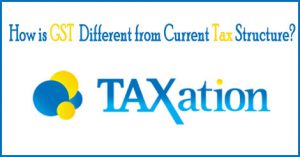
In this article you can find all differences between Present Tax Structure and Goods and Service Tax Structure like – Difference between Broad scheme, Difference between Tax rates, Difference between Tax burden, Difference between Concurrent Power, Difference between Compliance, Difference between Transparent Tax Administration, Difference between Cascading effect etc.
Present Tax Structure Vs GST Structure
| S.N. | Issues | Present Structure | GST Structure |
| 1 |
Broad scheme
|
There are separate laws for separate levy. For e.g. Central Excise Act, 1944, respective State VAT laws.
|
There will be only one such law because GST shall subsume various taxes as specified above. |
| 2 | Tax rates | There are separate rates. For e.g. Excise 12.36 % and Service Tax 15%. | There will be one CGST rate and a uniform rate of SGST across all states. |
| 3 | Cascading effect | This Problem arises because credit of CST and many other taxes not allowed. | This situation will not arise as CST concept is being eliminated with introduction of IGST. |
| 4 | Tax burden | Under present scenario, tax burden on tax payer is high. | Under this, tax burden is expected to reduce since all taxes are integrated which make it possible the burden to be split equitably between manufacturing and services |
| 5 | Cost Burden on Consumers | Due to presence of cascading effect, certain taxes become part of cost. | As GST mechanism removes such effect by providing credit, cost burden is reduced. |
| 6 | Concurrent Power | At present, there is no such power to both Centre and State on same subject tax matter | Both Centre and State are vested with the power to make law on GST by virtue of proposed Article 246A of the Constitution |
| 7 | Compliance | Tax compliance is complex because of multiplicity of laws and their provisions to be followed. | Tax compliance would be easier as only one law subsuming other taxes need to be followed |
| 8 | Transparent Tax Administration | Presently, tax is levied at two stages in broad manner i.e. 1. When product moves out of factory. 2. At retail outlet. | GST is to be levied only at final destination of consumption and not at various points. This brings more transparency and corruption free tax administration. |

